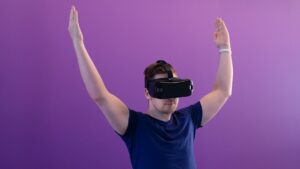1. Walmart – testing AR for inventory
In October 2020, Walmart announced that it would be turning four of its physical retail stores into ‘test stores’ for the purpose of trying out new technology (with the aim of enhancing all stores to become both physical shopping destinations andonline fulfilment centres).
An important element of these stores is inventory control, with one test involving an app that is designed to speed up the time it takes to transport items from the backroom to the sales floor. The app uses augmented reality to do so, allowing employees to hold up a handheld device (which will then highlight the boxes ready to go), rather than scanning each individual box.
This is one example of augmented reality being used to enhance internal processes, effectively creating a more seamless and faster workflow. Despite not being visible to customers, Walmart says that “regardless, it’s the customer who will benefit”, with the technology ultimately helping to enhance the customer experience by putting more products on shelves, faster than before.
2. Snap – City Painter
In October 2020, Snap unveiled ‘City Painter’ in London’s Carnaby Street. The AR tool enables users to virtually spray paint above the street’s shops, decorating them with pre-created murals. One of the most unique aspects of ‘City Painter’ is that it is a shared augmented reality experience, meaning any changes that a person makes is seen in real-time by others using it.
‘City Painter’ is the first major example of Local Lenses – Snap’s ambition to create a shared virtual world by mapping major landmarks. In a promotional video the company explains that by “using various sources of data, 360-degree images, and community snaps – we are able to build up a digital representation of the physical world.”
As the tool progresses, there will undoubtedly be potential for brands to get involved, particularly tourism or travel brands that want to capitalise on the renewed consumer desire for exploration and adventure.
3. ASOS – ‘See My Fit’
Asos is no stranger to mobile innovation, having previously integrated visual search into its highly usable mobile app. By 2019, Asos had fully got on board with AR, launching an experimental AR feature called Virtual Catwalk, designed to help app users visualise 100 Asos Design products.
As the pandemic hit in 2020, models and photographers were forced to work from home, resulting in Asos’ decision to scale up use of ‘See My Fit’ technology – which uses augmented reality to ’digitally fit’ clothing onto models.
As well as allowing Asos to solve a pressing issue – enabling the website to be rapidly updated with new inventory on a weekly basis – ‘See My Fit’ also serves to enhance the customer experience, by showing shoppers how products realistically look in different sizes and on different body types. In turn, this experience can help to drive sales as well as reduce returns.
Asos’ digital innovation has certainly contributed to its success over the past 18 months, culminating in revenues jumping 24% in the six months to the end of February 2021.
4. Pull & Bear – video game
Inditex, the owner of retail brand Pull & Bear, has launched ‘Pacific Game’ – an AR game created in collaboration with Facebook’s ‘Creative Shop’. The game involves a virtual trip from California to Tokyo, during which users then move their heads in order to dodge obstacles and collect points along the way.
Largely designed for social media, the game is available to play through Instagram and Facebook as well as the retailer’s own website. On Instagram, specifically, users can play through Instagram’s front camera feature.
While luxury fashion retailers like Gucci and Moschino have already expanded into the gaming market, this marks one of the first examples of a more affordable brand doing so, with the aim of reaching the 90% of Generation Z who are also gamers.
5. Burberry – Olympia Pop Up at Harrods
Retail brands are re-imagining AR experiences in order to bring customers back to stores, post-pandemic. Burberry is one such example, recently launching a pop-up AR experience in Harrods to coincide with the launch of its new Olympia bag. Using a QR code found in-store, customers will be able to watch the Elphis statue walk around in their surroundings, as well as take a photo or video to share with friends.
While this type of experience has certainly been done before – and adds little more than a bit of immersive excitement to the shopping experience – AR has taken on a new importance for both brands and consumers in the wake of Covid-19. And the hope is that it will draw luxury consumers back into physical stores as lockdown measures lift.
According to Burberry, “the experience is the latest in a series of activations exploring the relationship between physical and digital experiences to create exciting new concepts for our community and enhance the luxury experience.”

Average Rating